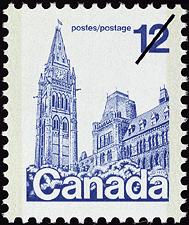Parliament Buildings - 12 pence 1977 - Canadian stamp
Specifications
- Quantity: BABN: 233 700 000
CBNC: 536 800 000 - Issue date: May 3, 1977
- Printer: British American Bank Note Company
Canadian Bank Note Company, Limited
Errors, freaks and oddities from the community
| # | Title | Source |
|---|---|---|
| #45 | Parliament Buildings - 12 pence 1977 - Canadian stamp - Ink stains | - |
Description
As one of our few national shrines, the Parliament Buildings in Ottawa symbolize Canada to millions of people from Newfoundland to British Columbia. The magnificent Centre Block, with its richness and variety, has a special appeal to the many groups making up our diverse country. The edifice contains the House of Commons, the Senate, and offices for various members of these august bodies. The Peace Tower contains the Memorial Chamber, dedicated to the memory of those who gave their lives in the Nile Expedition, the South African War, World Wars I and II, and the Korean War. The Parliament Buildings represent a fertile blending of the elements of modern democracy with traditions dating back to the Middle Ages. Queen Victoria's selection of the remote, turbulent timber settlement of Ottawa as Canada's capital annoyed many. She had made a shrewd choice, however, because Ottawa was advantageously situated on the border of what are now the provinces of Quebec and Ontario, the city was relatively safe from attack by the United States, and there was no general agreement in the Canadas on the other contenders for capital: Quebec, Montreal, Kingston and Toronto. The site of the new Parliament Buildings was a twenty-nine acre tract overlooking the mighty Ottawa River. The government held a design competition, offering a 250 Sterling pounds prize for a "plain, substantial" main building. Designs entitled Classic, Italian, Norman, Elizabethan, Lombard-Venetian, Civil-Gothic and something called "Plain Modern" soon arrived. The architectural firm of Fuller & Jones won the contract, though Frederick William Cumberland of Toronto may have inspired their Gothic Revival plan. Work proceeded despite problems with the excavations and a royal commission investigation of cost overruns. During peak construction periods, as many as 1,700 men and boys were employed at salaries ranging from 80¢ a day for labourers to $2.45 a day for stone and wood carvers. The finished product was one of the most important buildings of its decade in the world. This splendid representation of Canada's national style unfortunately burned down in 1916. Only the Library of Parliament survived. The Government hired Toronto architect John Pearson to resurrect the Centre Block. The Duke of Connaught relaid the corner stone on 1 September 1916. By 1920, with wartime and post wartime construction difficulties overcome, a new improved structure opened for business, though the famous Peace Tower was not ready until 1927. Today the beauty and meaning of the Houses of Parliament make them the centre of our national life. The Houses of Parliament stamp features an oblique view of the Centre Block in which the Peace Tower predominates. The Canadian flag is flying atop the tower. The stamp, which is engraved in one-colour steel, is based on a high-contrast photograph by Reinhard Derreth of Vancouver.
Canada. Post Office Department. [Postage Stamp Press Release], 1977.
Creators
Engraved by Yves Baril
Designed by Reinhard Derreth
Right now on Ebay (Ad)
Stampsandcanada.com is supported by its audience. When you buy through links on our site, we may earn a commission.
View more »Note
The values on this page are in Canadian dollars (CAD).

